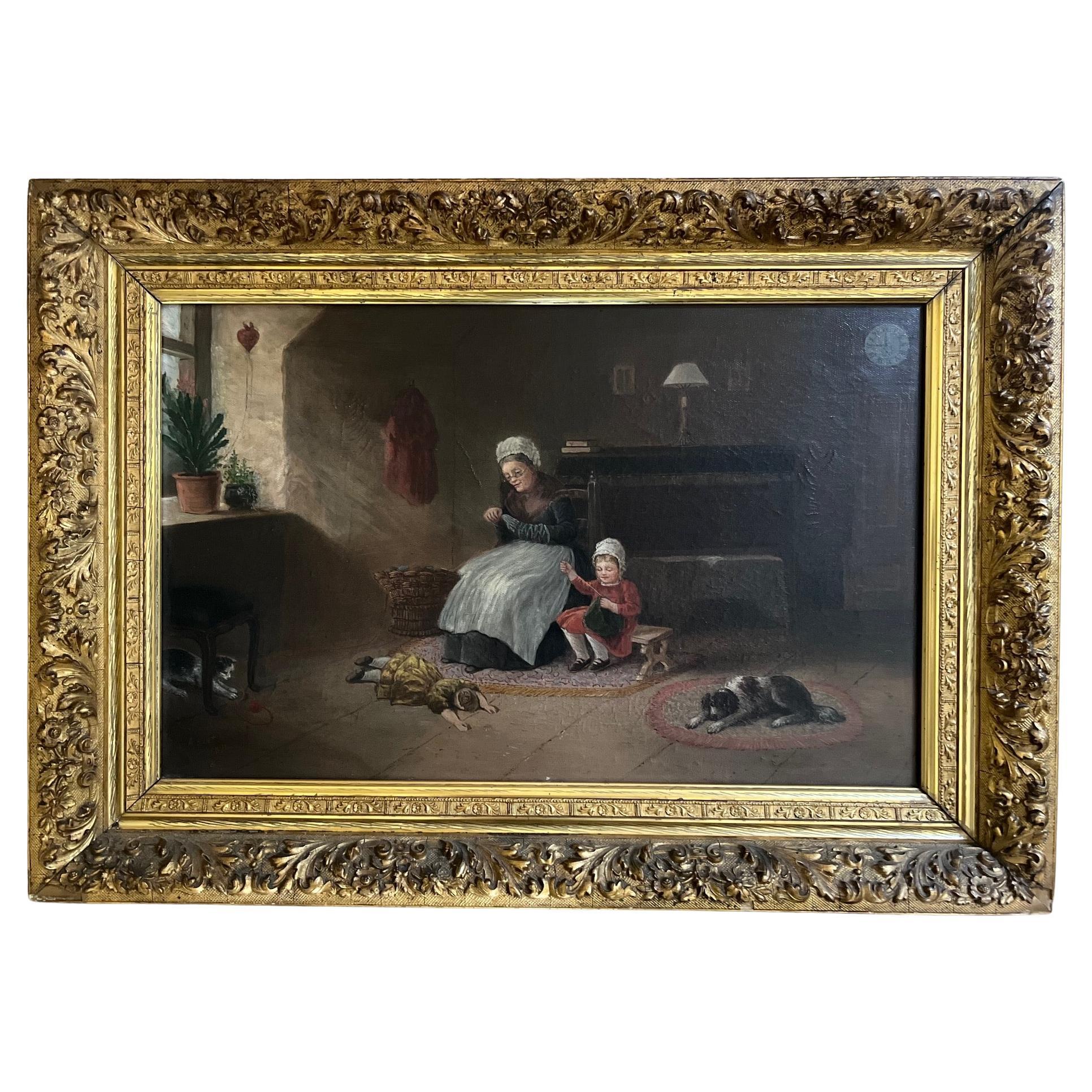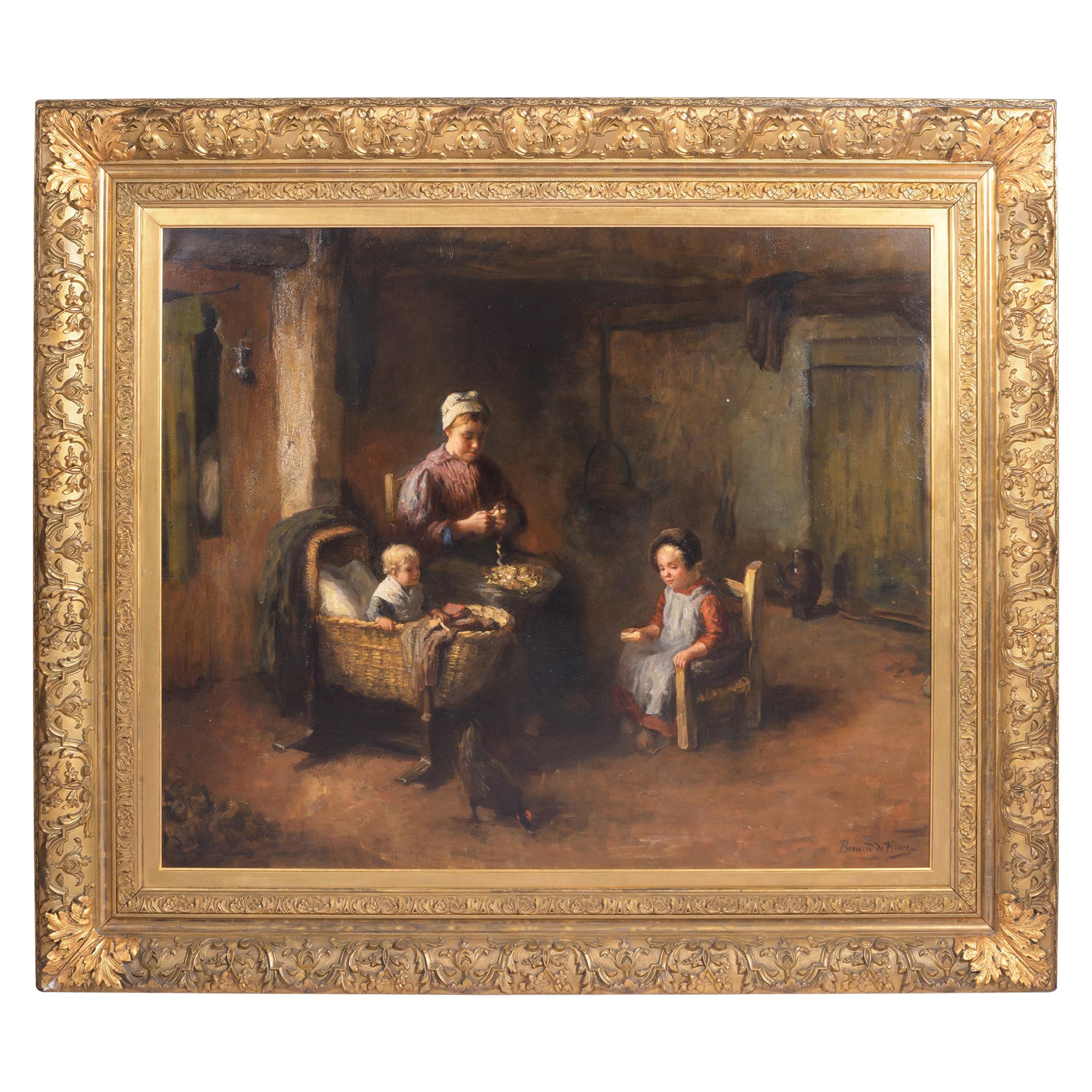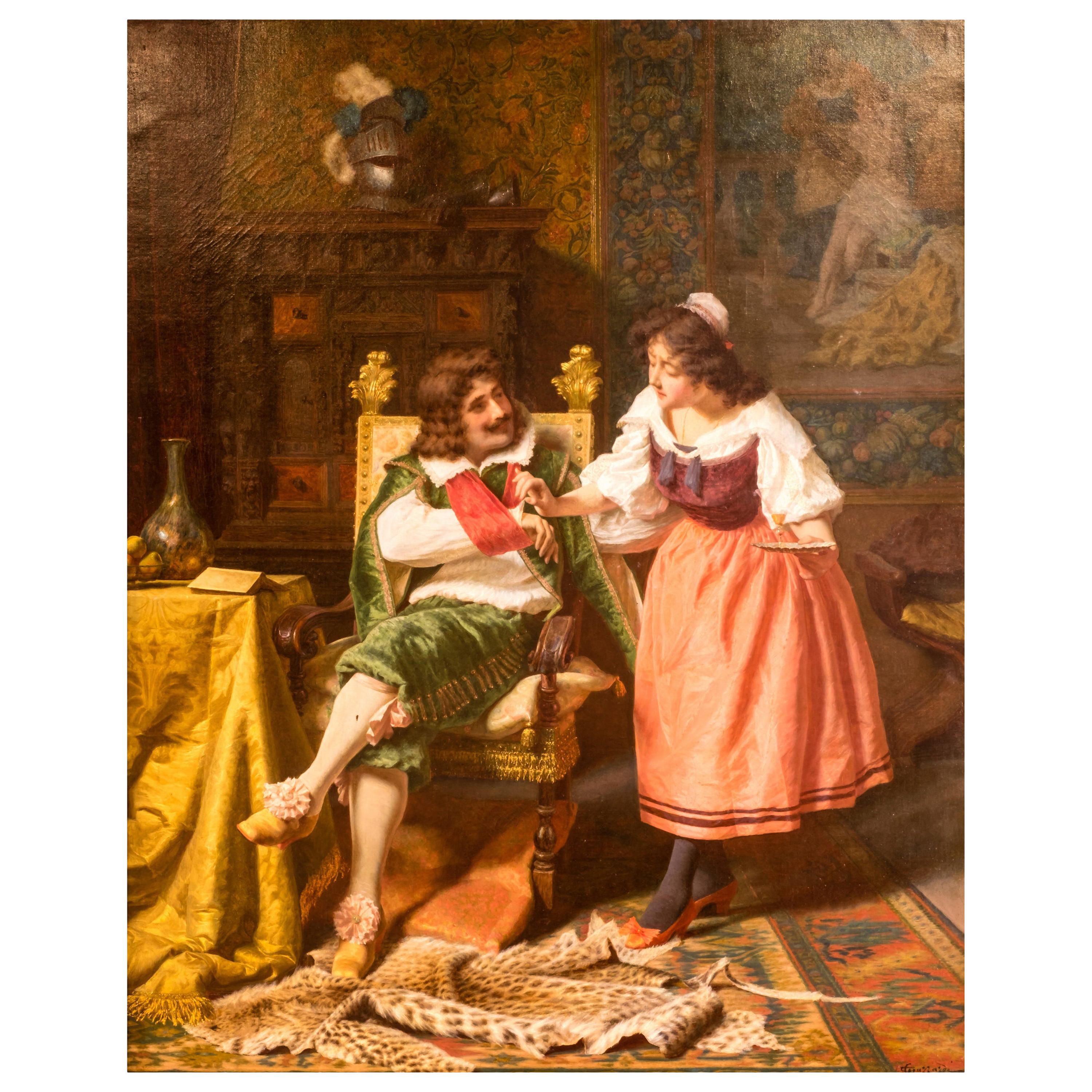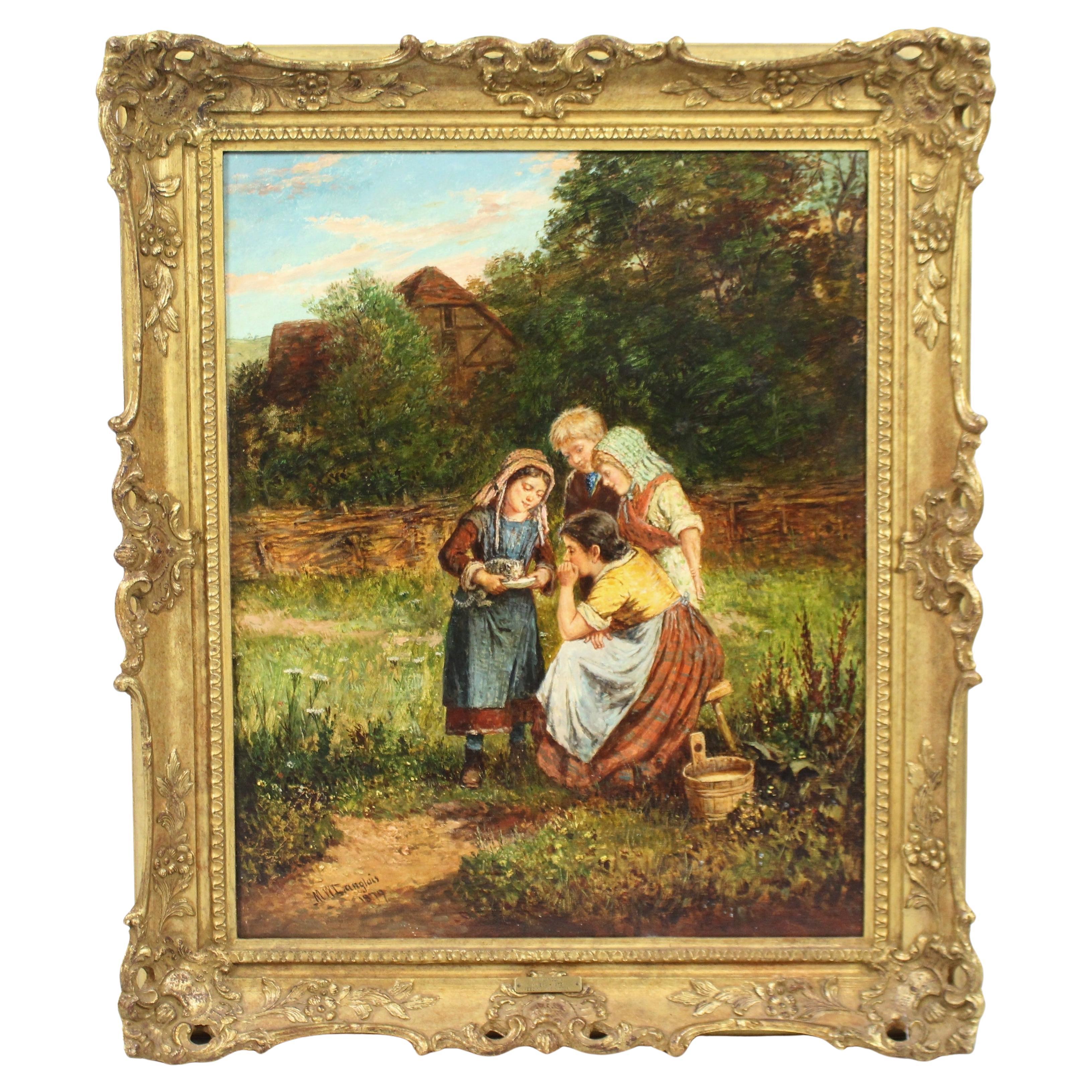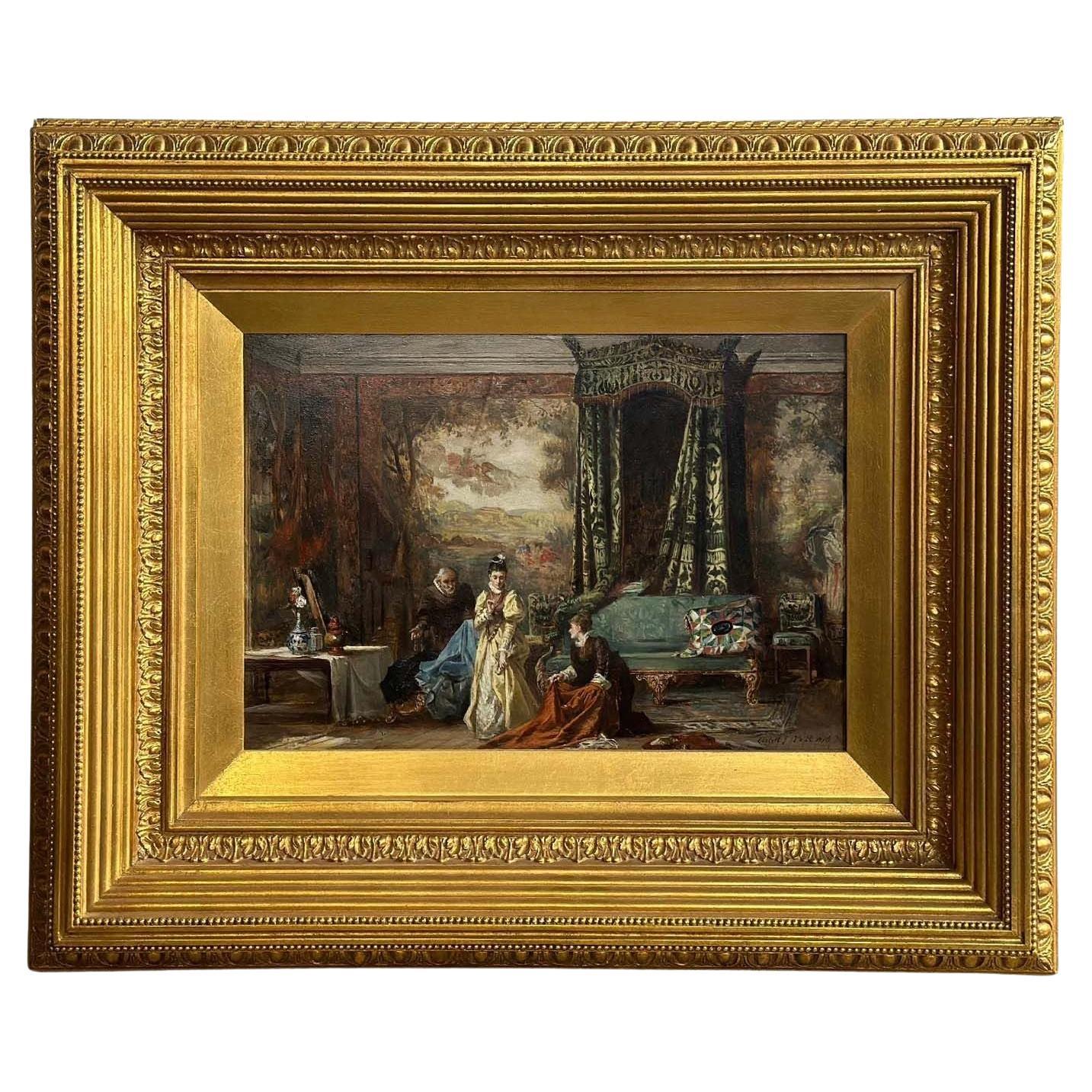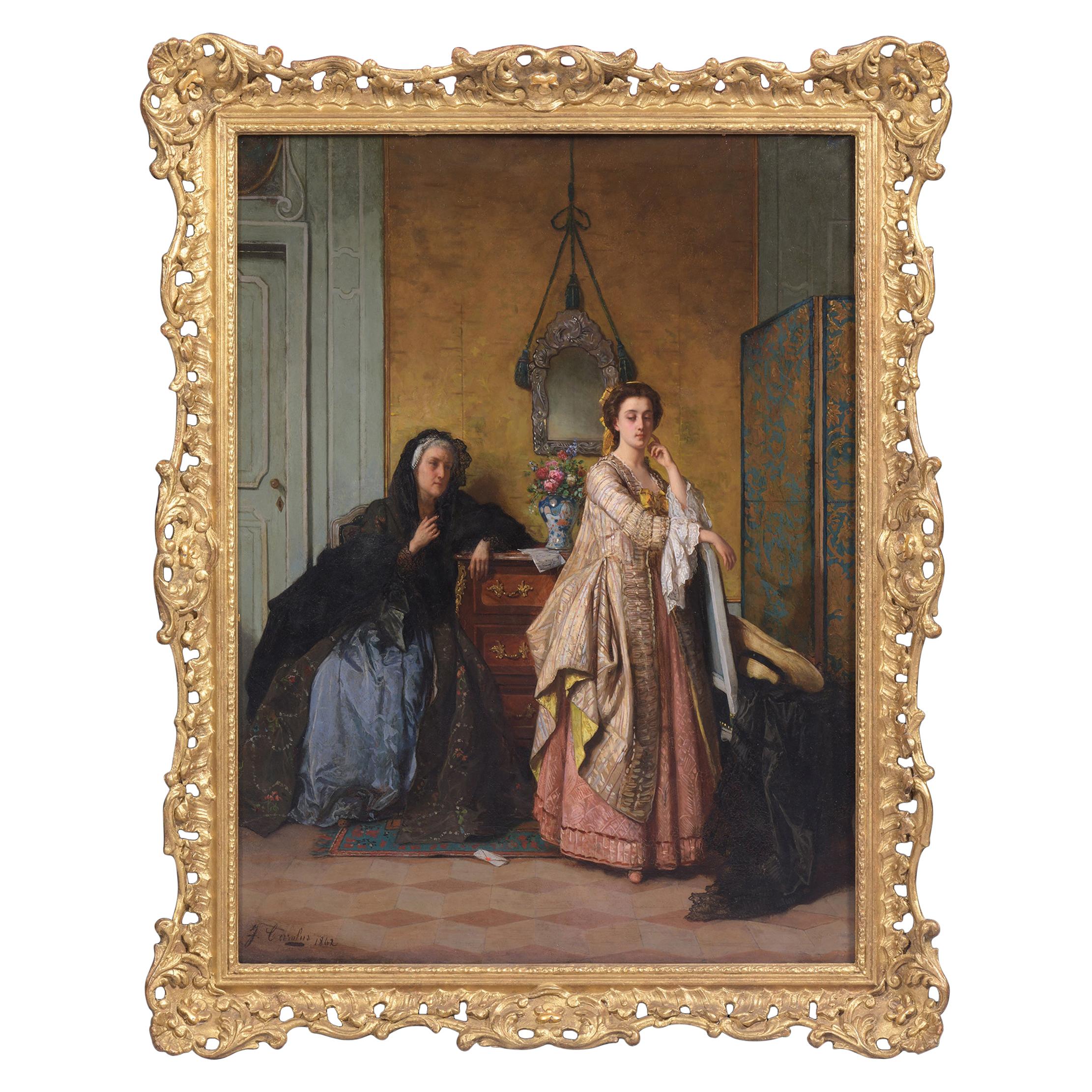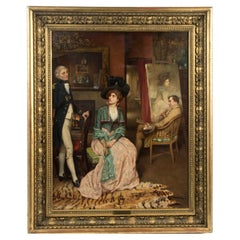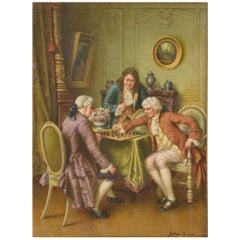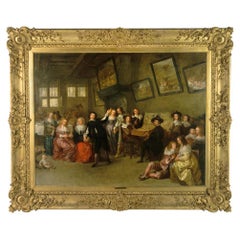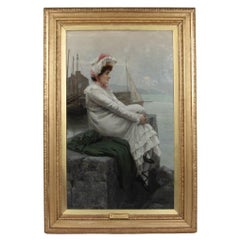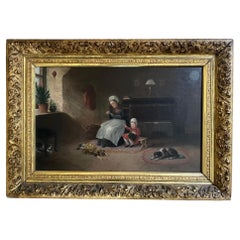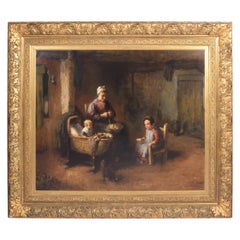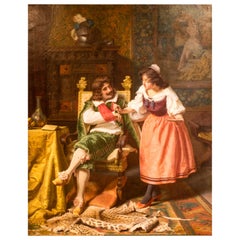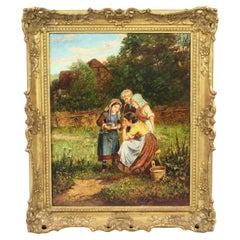Items Similar to A Genre Interior Scene Painted by Jules Ruinart de Brimont (1838-1898)
Want more images or videos?
Request additional images or videos from the seller
1 of 5
A Genre Interior Scene Painted by Jules Ruinart de Brimont (1838-1898)
$7,738.05
£5,700
€6,682.17
CA$10,655.37
A$11,925.32
CHF 6,242.48
MX$144,871.01
NOK 79,263.62
SEK 74,798.76
DKK 49,860.75
About the Item
This fine oil on canvas shows three female generations of the same family, grandmother, mother and daughter, in the interior of a country cottage. The youngest of the three women seemingly being admonished by her grandmother for some misdemeanour or perhaps advised as to her moral conduct going forward. The girl cannot meet her grandmother’s gaze and stares down at a table, holding on to the side of a chair with one hand. The pieces of decorative art such as pieces of faience pottery and a wall clock particularly finely observed. A fine example of the work of this very talented artist whose career, as outlined below, is under-studied.
Although paintings by Ruinart have appeared on the market many times, his biography has remained elusive with only his dates of birth recorded and auction houses and dealers alike stating that his career was undocumented. Our research in the French newspaper archives has changed this. An article written shortly after the artist’s death in L’Independent Remois, 29th of November 1898, gives many details about the artist, his inspiration and his work and is reproduced below in full in English translation.
‘A Champagne Artist
Jules Ruinart de Brimont
While there are artists who desire fame and spare no effort to make themselves known, there are others whose private lives, entirely devoted to work, remain unknown to the general public, and whose talent is matched by their modesty.
It is among these that we should rank our compatriot Jules Ruinart, who died last summer in his hermitage in Rilly.
Jules Ruinart de Brimont, descended from one of the oldest and finest Champagne families, was born in Coblenz in 1838 during a stay his parents made there. From early childhood, he developed a strong taste for drawing; therefore, at the age of fourteen, he entered the Antwerp Academy of Fine Arts, where he remained for two years. He then studied at the famous Dusseldorff School under Rudolph Jordan (painter of scenes depicting the lives of fishermen on the island of Markeu, in Holland) and Oswald Achenbach, whose talent is too well known and appreciated for us to discuss it.
Jules Ruinart left the Dusseldorff School after two years to try his hand at a series of genre paintings, inspired by the customs of Westphalia and the banks of the Rhine. He was then 18 years old.
He undertook the Italian voyage, dreamed of by all artists, and stayed six months in Rome, and six months in Naples and Capri.
It was then that, captivated by the beauty and marvellous light of the Italian landscapes, and feeling, in this regard, the inadequacy of his studies, Jules Ruinart had the courage to return to Dusseldorff and asked to attend the Academy’s landscape classes.
After a few months, he was granted a master studio, a secluded studio where the directors came to examine his work and offer advice. The student’s progress was so noticeable that the Academy purchased his first major painting from him for 2,000 francs (a huge sum for the time).Then the war of 1870 broke out, and Ruinart left Germany to return to France, where he settled in Rilly. Since that time, he made frequent trips to England, Holland, Belgium, Germany, Bohemia, Spain, and Italy, continually studying, painting, and drawing, drawing from everywhere the most varied subjects of moral scenes, genre scenes, and landscapes.
Jules Ruinart did not much like to be in the world, although he himself kept the best company; he preferred, in keeping with his artistic tastes, to live simply, without noise or clamour, surrounded by the landscapes and peasants who served as his models every day. It was in this environment, which was dear to him, that he ended his days, leaving in his studio an unsuspected quantity of paintings, drawings, sketches, watercolours, and sketches, many of which were by a master. The sale of all these works, we are told, will take place in the auctioneers’ room on Saturday, December 3, and the public exhibition the day before. We urge our compatriots to visit this exhibition which, better than the lines we have just written, will be able to give them an idea of the value of the artist we have lost’.
We have conducted additional research in the British Newspaper Archive and Ruinart exhibited frequently in Britain during the 1870s and 1880s though the first reference we have found comes from The Tablet, 17th of July 1869. In the article ‘Fine Arts in France’, a Ruinart work on exhibition in the Palais de Champs-Élysées is discussed by the author.
‘Jules Ruinart paints for us “Un Portrait d’une Religieuse” with the clam and happy air that one rarely sees but through a convent grille‘.
In the Birmingham Daily Gazette, 4th of September 1871, a review of the exhibition of the Royal Society of Artists’ annual exhibition includes a reference to Ruinart’s work.
‘Just below is a picture (62) by, we presume, a German artists, Jules Ruinart, of a girl with a water-can; in treatment the direct antithesis of Mr Hills-sombre in colour, carefully elaborate in finish and drawing’.
The South Wales Daily News, 18th of August 1881 carried a feature on the Cardiff Fine Art Exhibition and Ruinart’s entry was described as follows:
‘”A Funeral at Rome”, by Jules Ruinart. A very good picture’
The South Bucks Free Press, 26th of May 1882, reported on the Loan Picture Exhibition in Aid of the Wycombe Literary and Scientific Institute.
‘No. 350 (“Hastings Beach”, by Jules Ruinart), which will deserve more than a passing notice’
Finally, The Hastings and St Leonards Observer, 19th of November 1887, previewed the forthcoming exhibition of the Hastings Sketching Club. This was an exhibition of pieces largely drawn from local private collections rather than from the artists themselves and three works by Ruinart were to be on display. They were sent to the exhibition by the artist himself.
‘M. Ruinart sends “Girl with fruit”, ”A canal in Italy”, “An errand for mother” and “Neapolitan boys”, all by Jules Ruinart’
Provenance
From a private collection.
- Dimensions:Height: 40.5 in (102.87 cm)Width: 35 in (88.9 cm)Depth: 3.75 in (9.53 cm)
- Materials and Techniques:
- Place of Origin:
- Period:
- Date of Manufacture:1838-1898
- Condition:Wear consistent with age and use.
- Seller Location:Lymington, GB
- Reference Number:1stDibs: LU973045718902
About the Seller
5.0
Recognized Seller
These prestigious sellers are industry leaders and represent the highest echelon for item quality and design.
Established in 1982
1stDibs seller since 2013
132 sales on 1stDibs
Typical response time: 2 hours
Associations
LAPADA - The Association of Arts & Antiques Dealers
- ShippingRetrieving quote...Shipping from: Lymington, United Kingdom
- Return Policy
Authenticity Guarantee
In the unlikely event there’s an issue with an item’s authenticity, contact us within 1 year for a full refund. DetailsMoney-Back Guarantee
If your item is not as described, is damaged in transit, or does not arrive, contact us within 7 days for a full refund. Details24-Hour Cancellation
You have a 24-hour grace period in which to reconsider your purchase, with no questions asked.Vetted Professional Sellers
Our world-class sellers must adhere to strict standards for service and quality, maintaining the integrity of our listings.Price-Match Guarantee
If you find that a seller listed the same item for a lower price elsewhere, we’ll match it.Trusted Global Delivery
Our best-in-class carrier network provides specialized shipping options worldwide, including custom delivery.More From This Seller
View AllAdmiral Viscount Nelson and Lady Emma Hamilton in the Studio of George Romney
Located in Lymington, Hampshire
This oil painting shows the fictional scene of Emma, Lady Hamilton meeting Lord Nelson in Romney’s studio. She is seated for her portrait wearing a full pink skirt under a tightly f...
Category
Antique 1880s English Paintings
Materials
Paint
Antique Oil Painting by Georges Dupre
By Georges Dupre
Located in Lymington, Hampshire
Oil on board with two men playing chess in an 18th century interior while a third smokes a clay pipe, in the original frame, signed.
Category
Antique 19th Century French Paintings
Materials
Paint
Elegant Musical Party in an Interior’ Attributed to Gillis Van Tilborgh
Located in Lymington, Hampshire
An Elegant Musical Party in an Interior’ attributed to Gillis van Tilborgh, oil on canvas depicting a Dutch genre scene with figures dressed in rich silk clothing, fine lace ruffs and fichu collars grouped round musicians playing a clavichord, a fiddle and a flute, some couples holding hands or sitting close together and a baby playing on the floor, with a plaque reading ‘Gerard Terburg 1608-1681’, the reverse with a chalk notation ‘Ld Hesketh’. Dutch, circa 1870.
Provenance: George, 3rd Earl of Pomfret (1768-1830), or his brother The Hon. Thomas Fermor, later 4th Earl of Pomfret (1770-1833), Easton Neston.
Thence by descent, Lord Hesketh, Easton Neston.
His Sale, Sotheby’s London, 17-19 May 2005, lot 82. Private Collection.
Literature: George Baker...
Category
Antique 19th Century Dutch Paintings
Materials
Canvas, Paint
A Fine Oil on Canvas of the ‘Lass That Loved a Sailor’ by Julius Mendes Price
Located in Lymington, Hampshire
A Fine Oil on Canvas of the ‘Lass That Loved a Sailor’ by Julius Mendes Price, 1906
Depicting a finely and fashionably dressed lady, sitting on a quay staring out to sea, ships visi...
Category
Early 20th Century English Paintings
Materials
Canvas, Paint
Clarkson Stanfield: The Gulf of Salerno
Located in Lymington, Hampshire
Clarkson Stanfield: The Gulf of Salerno
This oil painting on canvas shows commercial shipping and fishermen in the Gulf of Salerno. The tower at Vietri is visible in the background...
Category
Antique Mid-19th Century English Paintings
Materials
Canvas, Paint
‘Tea at the Vicarage’ by Margaret Dovaston, Dated 1952
By Margaret Dovaston
Located in Lymington, Hampshire
‘Tea at the Vicarage’ by Margaret Dovaston, dated 1952, an oil painting showing four gentlemen having an earnest conversation over a cup of tea on a terrace outside a cottage garden, Margaret Dovaston, dated 1952. English.
Margaret Isabel Dovaston (1884 – 1954) was a British artist who became particularly well known for her historical genre scenes, often depicting groups in Georgian costume. In the course of her education, she was taught by Thomas William Cole at the Ealing School of Art and Arthur Stockdale Cope at the South Kensington School of Art. Her crowning achievement was winning a five-year scholarship the to the Royal Academy Schools (1903-1908) where she won many medals. She exhibited at the Royal Academy (1908 and 1910) and helped set up The Ealing Art...
Category
Vintage 1950s English Mid-Century Modern Paintings
Materials
Paint
You May Also Like
Antique Oil Painting of Interior Scene, Signed A. Hart, 1892
Located in Ross, CA
Antique oil painting dated 1892 and signed by the artist as A. Hart. The sweet interior scene shows a grandmother sewing with a granddaughter, with the doll thrown on the floor and ...
Category
Antique 1890s Unknown Late Victorian Paintings
Materials
Paint, Plaster, Giltwood
Bernard De Hoog, 'Dutch, 1866-1943' Genre Scene, 19th Century Art Interior Scene
By Bernard De Hoog
Located in Dublin, IE
Artist: Bernard de Hoog (1826-1943), Dutch
Titled: Mother feeding her child in a kitchen interior
Signed: Lower right
Medium: Oil on canvas. In original gilt frame.
Dimen...
Category
Antique Late 19th Century Dutch Victorian Paintings
Materials
Canvas
Interior Scene, Oil on Canvas, 19th Century
Located in Lantau, HK
A 19th century genre painting by the colorful scene is set in a reading room, where the elegantly dressed nobleman, who recently fought in ...
Category
Antique 19th Century European Paintings
Materials
Canvas
Mark William Langlois (British, 1848–1924) Oil on Canvas
Located in Worcester, GB
Mark William Langlois (British, 1848–1924)
“Feeding the Kitten”, 1879
Oil on canvas, signed and dated
A beautifully composed and sensitively rendered 19th-century English oil painti...
Category
Antique Late 19th Century European Paintings
Materials
Canvas
British Framed Painting by Laslett John Pott, 1876
Located in Los Angeles, CA
Beautiful antique oil on panel depicting Amy Robsart having her wedding dress shown in her master bedroom. It is protected by a gilt wood frame. Signed "Laslett J. Pott" and dated 18...
Category
Antique 1870s British Paintings
Materials
Giltwood, Paint
19th Century Painting by Jean Carolus, Belgium Romanticism
By Jean Carolus
Located in Dublin, IE
Artist: Jean Carolus
Painted: 1862
Medium: Oil on board
Interior Scene
Period: Romanticism
Signed & Dated: Lower left J. Carolus 1862
Dimensions:
H: 24 3/4 / 62.8 cm
W: 18 3/4...
Category
Antique 19th Century French Romantic Paintings
Materials
Canvas
More Ways To Browse
Italian Pottery 19th
17th Antique Clock
Holland Wall Clocks
Antique Spanish Clocks
17th Century French Pottery
Antique Clock Auctions
Antique Bank Clock
Antique Pottery Banks
The Rudolph Collection
18th Century German Clock
Grandmother Clocks
Royales De Champagne
18th Century Dutch Clock
Naples Pottery
18th Century German Faience
Antique Dutch Wall Clocks
Antique Grandmothers Clock
French Faience Clock
